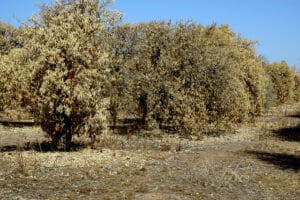 In early 2015, Governor Kate Brown declared a state of drought emergency in counties throughout Oregon. This is the first drought in the state since 2004. Drought can devastate agriculture, threaten livestock, and deplete natural resources. Another potentially major consequence of drought is compromised tree health. As we head into what wildfire experts are saying could be the driest summer in twenty-five years, it’s critical to preserve your own trees by brushing up on Portland tree care for drought.
In early 2015, Governor Kate Brown declared a state of drought emergency in counties throughout Oregon. This is the first drought in the state since 2004. Drought can devastate agriculture, threaten livestock, and deplete natural resources. Another potentially major consequence of drought is compromised tree health. As we head into what wildfire experts are saying could be the driest summer in twenty-five years, it’s critical to preserve your own trees by brushing up on Portland tree care for drought.
Portland Tree Care: Tending to Your Trees During a Drought
- Recognize Signs of Tree Stress
To properly mitigate the risks of drought, knowing the symptoms of tree stress is a good place to start. The first, and perhaps most, devastating damage occurs long before any apparent signs of trouble, in the form of root damage below the soil. In an attempt to amend the imbalance of this root loss, the thinning of the tree canopy may occur.
Evergreens demonstrate stress through the discoloration of their needles, sometimes turning brown at the tips, progressing through the needle towards the twig. At other times needles may turn yellow, red, or even purple. Deciduous trees may acquire “scorch,” in which leaves brown between veins or on the outside edge. Other drought stress symptoms may include leaves that wilt, yellow, and curl.
A side effect of drought is the onslaught of unscrupulous pests and diseases, including boring insects and fungal pathogens. Stressed trees go through chemical changes that attract opportunist pests. A tree weakened by drought provides easy access for infestation and pathogens.
- Caring for Trees During Drought
While providing Oregon tree care services, we’ve seen a few common mistakes among well-meaning homeowners hoping to nourish their trees through dry spells. A common mistake is watering at the base of a tree, which is not where it finds its nourishment. Another is fertilizing during signs of drought stress, which can cause root burn. Instead, refrain from fertilization during drought, and water beyond the tree’s drip-line to reach the full expanse of the roots. Here’s a quick rule of thumb: Look at the height of the tree, and imagine roots growing two to four times that distance down into the earth. So watering farther around the circumference of the tree will help ensure that it is thoroughly nourished.
It is also important to make sure that moisture reaches twelve to eighteen inches below the surface—otherwise, the tree will not be able to absorb enough water. You can use a soil probe to help you determine when this has been accomplished. To retain moisture between watering, layer four or five inches of organic mulch on the soil surface, six inches from the trunk of the tree. Remember to also properly prune away dead or infested branches to improve the tree’s overall health. Prioritize watering young or new trees, trees that have recently received root injury due to construction, and trees that are growing in a restricted root zone, such as next to a sidewalk.
Tree watering is important all year round. In April to September you should water about three times a month, and in October through March water one to two times per month.
Despite the wealth of information on tree care it may still be challenging to determine the state of your trees in a drought and what steps to take to preserve the life of the tree. Fortunately, our Portland certified arborists are ready to help you mitigate the early and unnecessary death of a tree. Even the most caring amateur homeowner may fall short in tree care during challenging seasons. Contact us to arrange for consistent tree care during this hot, dry summer.